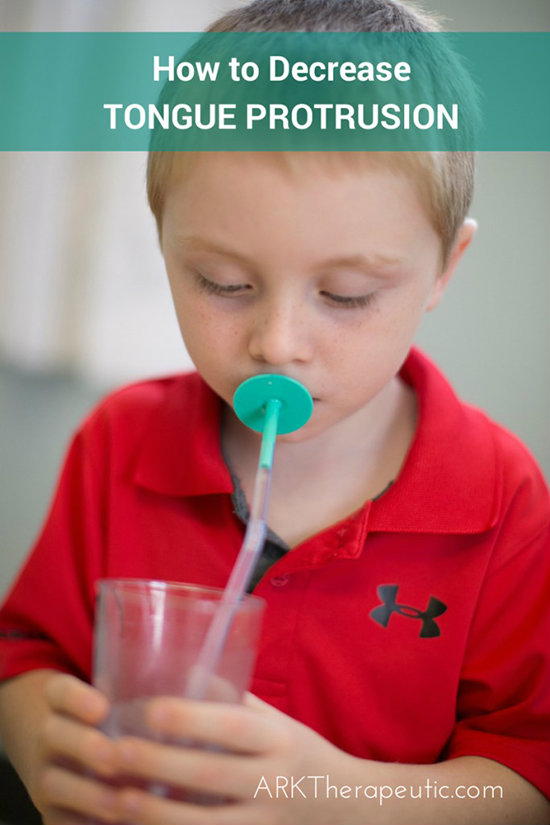How to Decrease Tongue Protrusion & Encourage Retraction
Posted by Debra C. Lowsky, MS, CCC-SLP on 17th Oct 2014
Question: I have a 2 year old on my EI caseload, our program purchased a z-vibe kit for him. He is demonstrating some sensory aversion, drooling, and an open mouth posture with tongue protrusion. His tongue protrusion is beginning to affect production of his speech sounds. Are there any specific exercises I can have him do to decrease tongue protrusion? Thank you so much for your help!
.
The issues you mentioned are likely all connected. Let’s tackle the tongue protrusion first. In order to help you visualize what he needs to work on: hold your mouth open, bring your tongue forward between your teeth, and have the tongue tip/blade rest on your lower lip. Now pull it back into your mouth with your tongue tip and front part of the tongue blade positioned on alveolar ridge (the gum area right behind the upper front teeth). Commonly known as “SPOT,” this is where the tongue tip should be when we’re not eating, drinking, or speaking. It’s also where the tongue tip sounds (t,n, d, s, z, l) are made.
There are many strategies you can use to get the tongue toned, tightened, and retracted so that it's on SPOT. The first thing I always recommend is to get him on straws, as these naturally encourage oral motor skills and decrease tongue protrusion. If he doesn’t drink from a straw yet or if he has a weak suck, the Bear Bottle Straw Cup makes the transition easier.
.

.
Ideally, you’ll want him to drink out of a straw using a Lip Blok (the child pictured above is using one). These mouthpieces go in the top of straws to discourage kids from biting on the straw for stability (instead of using their mouth muscles) and from putting the straw too far into the mouth. You’ll start with the longest mouthpiece (the yellow one). Then once he’s comfortable drinking at that length, he’ll progress to the blue one and eventually to the turquoise one. This hierarchy will slowly teach him to put less and less of the straw into his mouth so that fluid is deposited in the front of the mouth where it is easier to manage. And also, the less of the straw that’s in the mouth, the more the lips have to seal, the more the tongue has to tighten and retract, and the more the cheeks have to be taut.
With the Z-Vibe (with or without vibration), you can stroke the top of the tongue from back to front to encourage the tongue to move back. The Z-Vibe can also help with the drooling and sensory issues, I’ll link out to more on both of these topics below. Whistles are also an effective (and fun!) tongue retraction exercise.
Now, the open mouth posture is very likely contributing to both the tongue protrusion and the drooling. When the mouth is open, the tongue tends to fall forward and so does saliva. Why is the mouth open? If the child has regular sinus congestion / respiratory issues, that's likely forcing him to breathe out of his mouth (hence the open mouth posture). Consult with the pediatrician and ENT if necessary. Dentition is probably not applicable for a two-year-old, but as a note to others reading this, I have seen cases where the child's teeth prevent him/her from closing their lips. If so, consult with their dentist.
If the open mouth posture is because his jaw isn't strong enough to hold itself closed, encourage him to chew on either a Y-Chew or Grabber. Start with the standard ones and then progress to the XT ("Xtra Tough") ones to gradually build jaw strength. Simply chewing / mouthing these will help strengthen his jaw, while also exercising the lips and tongue. Once he's old enough to follow and understand directions, you can try these jaw strength exercises with him. You can also check out these oral motor activities, activities with lollipops, and exercises with the Z-Vibe for more ways to build oral tone and coordination.
You mentioned that he's also showing some signs of sensory aversions. I’m guessing he has hypo-sensitivities, as these tend to go hand in hand with drooling and tongue movement problems. With hypo-sensitivities, there is limited to no oral awareness in the mouth. If you can’t feel what's going on in your mouth, it's hard to know what to do with your tongue or saliva. Or, he could have hyper-sensitivities or a combination of both. This post on oral defensiveness will shed more light on that (pay particular attention to where the post mentions gum massage).
The drooling is most likely because of all of the above - open mouth posture, tongue protrusion, and low oral awareness - but you may also find some helpful information on drooling here and here as well.
As always, if any parents are reading this - I'd highly recommend an evaluation with a speech-language pathologist so he/she can assess what's going on in person. The above are only my best guesses without evaluating the child myself.
.
I hope you find some of this information helpful!
Debbie
Debra C. Lowsky, MS, CCC-SLP
.

